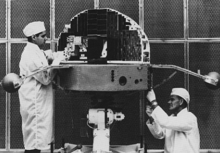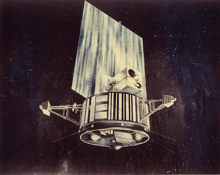Orbiting Solar Observatory
Orbiting Solar Observatory (OSO) was the name of a series of nine NASA satellites for exploring the sun, eight of which were successfully launched with Delta rockets between 1962 and 1975 . Their launch mass and scientific equipment increased with the introduction of ever stronger delta missiles. Their primary task was to observe the sun over an entire sunspot cycle of around 11 years in UV and X-ray light .
Structure of OSO 1 to 6 and C
The satellites OSO 1 to 6 (the failed satellite kept the letter from the project phase) had the same structure and consisted of a flat, octagonal prism. In the transverse plane, three legs, each offset by 120 ° to each other, started from this, at each end of which there was a spherical pressure gas tank with small nozzles, which were used to control the swirl of the main body. The entire main body, with the arms, rotated around its longitudinal axis for stabilization. On top of the cylinder was a semicircular shield that ran across the entire width of the cylinder, did not rotate with it and was always aimed at the sun. It carried the solar cells and, at the bottom in its center, the solar instruments.
Structure of OSO 7
OSO 7 was an improved model that retained the basic structure of the earlier OSO satellites, but was significantly larger so that more experiments could be accommodated. As the only satellite in the OSO series, it had no spin control arms.
Structure of OSO 8
OSO 8 was launched with a much more powerful Delta rocket (Delta 1910) than its predecessor. This rocket version also provided significantly more space for the payload. OSO 8 was therefore not only significantly heavier, but also significantly larger than its predecessor.
OSO 8 consisted of a flat cylinder. In the transverse plane, three legs, each offset by 120 ° to each other, started from this, at each end of which there was a box with small control nozzles. The entire cylinder with the arms rotated around its longitudinal axis for stabilization. On the top of the cylinder was a rectangular, sail-shaped shield that went beyond the width of the cylinder and was much higher than it was wide. It did not rotate and was always aligned with the sun. It carried the solar cells and, at the bottom in its center, the instruments pointing at the sun.
Results
The OSO satellites discovered u. a. the sun's coronal holes , which are particularly strong sources of solar wind . While the satellites were over the night side of the earth, they were used to observe galaxies and binary stars.
Web links
- OSO 1
- OSO 3
- OSO 4
- OSO 5
- OSO 6
- OSO 7
- OSO 8
- OSO Image Gallery with links to information pages about each OSO satellite.
literature
- Bruno Stanek: Raumfahrt Lexikon , Hallwag Verlag, Bern (1983), ISBN 3-444-10288-7 page: 218




